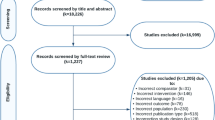Abstract
Objective
The purpose of this study was to examine recent trends in the prescribing of hormone therapy for menopause, tibolone, and bisphosphonate preparations for the prevention or treatment of osteoporosis, in the UK in relation to publication of research evidence on the health effects of hormone therapy and subsequent changes in prescribing advice.
Methods
Individual patient-level data were obtained on the prescribing of hormone therapy, tibolone, and bisphosphonates by general practitioners in the UK between 1991 and 2005 to women aged 40 years and older in the UK General Practice Research Database. Overall and age-specific prescribing prevalence were calculated for each therapy type. Prescribing prevalence was also calculated for subcategories of hormone therapy and bisphosphonates.
Results
Prescribing of hormone therapy to women aged 40 years and older increased between 1991 and 1996 and remained fairly stable between 1997 and 2001. Hormone therapy prescribing has fallen by about 50% since 2002. Tibolone, a selective tissue estrogenic activity regulator, is prescribed much less commonly than hormone therapy but shows a similar pattern. Prescribing of bisphosphonates increased rapidly throughout the study period, particularly in women aged 70 years and older, with the pattern of prescribing reflecting to some extent, the availability of new weekly formulations.
Conclusions
Trends in the prescribing of hormone therapy in the UK appear to closely reflect new epidemiological evidence and prescribing advice. It is likely that the substantial fall in hormone therapy and tibolone prescribing seen since 2002 is a direct consequence of the publication of Women’s Health Initiative trial results and subsequent changes in advice given by the Committee on Safety of Medicines. The 1997 publication of results from the Collaborative Group on Hormonal Factors in Breast Cancer and 2003 publication of the Million Women Study findings may also have impacted on trends, particularly within certain age groups. The substantial and continuing increase in prescribing prevalence of bisphosphonates reinforces the need for research into the long-term risks and benefits of these therapies.



Similar content being viewed by others
References
Stampfer MJ et al (1985) A prospective study of postmenopausal estrogen therapy and coronary heart disease. N Engl J Med 313(17):1044–1049
Stampfer MJ, Colditz GA (1991) Estrogen replacement therapy and coronary heart disease: a quantitative assessment of the epidemiologic evidence. Prev Med 20(1)47–63
Collaborative Group on Hormonal Factors in Breast Cancer (1997) Breast cancer and hormone replacement therapy: collaborative reanalysis of data from 51 epidemiological studies of 52,705 women with breast cancer and 108,411 women without breast cancer. Lancet 350(9084):1047–1059
Rossouw JE et al (2002) Risks and benefits of estrogen plus progestin in healthy postmenopausal women: principal results from the Women’s Health Initiative randomized controlled trial. JAMA 288(3):321–333
Medicines Control Agency (MCA)/Committee on Safety of Medicines (2002) ‘New product information for hormone replacement therapy’. Current Problems in Phamacovigilance, vol 28, April, 1–2
Beral V (2003) Breast cancer and hormone-replacement therapy in the Million Women Study. Lancet 362(9382):419–427
Anderson GL et al (2004) Effects of conjugated equine estrogen in postmenopausal women with hysterectomy: the Women’s Health Initiative randomized controlled trial. JAMA 291(14):1701–1712
Banks E et al (2004) Fracture incidence in relation to the pattern of use of hormone therapy in postmenopausal women. JAMA 291(18):2212–2220
Cauley JA et al (2003) Effects of estrogen plus progestin on risk of fracture and bone mineral density: the Women’s Health Initiative randomized trial. JAMA 290(13):1729–1738
Jackson RD et al (2006) Effects of conjugated equine estrogen on risk of fractures and BMD in postmenopausal women with hysterectomy: results from the women’s health initiative randomized trial. J Bone Miner Res 21(6):817–828
Medicines and Healthcare products Regulatory Agency (MHRA)/Committee on Safety of Medicines (2004) ‘Review of the evidence on long-term safety of HRT’. Current Problems in Phamacovigilance, vol 30, October, 4–6
General Practice Research Database (GPRD) (20/04/06) http://www.gprd.com
Joint Formulary Committee (2005) British National Formulary 50 ed. British Medical Association and Royal Pharmaceutical Society of Great Britain: London
Townsend J, Nanchahal K (2005) Hormone replacement therapy: limited response in the UK to the new evidence. Br J Gen Pract 55(516):555
Menon U et al (2007) Decline in use of hormone therapy among postmenopausal women in the United Kingdom. Menopause 14(3):462–467
Usher C et al (2006) Effect of clinical trial publicity on HRT prescribing in Ireland. Eur J Clin Pharmacol 62(4):307–310
Hersh AL, Stefanick ML, Stafford RS (2004) National use of postmenopausal hormone therapy: annual trends and response to recent evidence. JAMA 291(1):47–53
Gayet-Ageron A et al (2005) Estimated numbers of postmenopausal women treated by hormone therapy in France. Maturitas 52(3–4):296–305
Faber A et al (2005) Dramatic change in prescribing of hormone replacement therapy in The Netherlands after publication of the Million Women Study: a follow-up study. Br J Clin Pharmacol 60(6):641–647
Bromley SE, de Vries CS, Farmer RD (2004) Utilisation of hormone replacement therapy in the United Kingdom. A descriptive study using the general practice research database. BJOG 111(4):369–376
Udell JA et al (2006) Effect of the Women’s Health Initiative on osteoporosis therapy and expenditure in medicaid. J Bone Miner Res 21(5):765–771
Jick H, Jick SS, Derby LE (1991) Validation of information recorded on general practitioner based computerised data resource in the United Kingdom. BMJ 302(6779):766–768
Beral V, Bull D, Reeves G (2005) Endometrial cancer and hormone-replacement therapy in the Million Women Study. Lancet 365(9470):1543–1551
de Vries CS et al (2005) Tibolone and endometrial cancer: a cohort and nested case-control study in the UK. Drug Saf 28(3):241–249
Cummings SR (2006) LIFT study is discontinued. BMJ 332(7542):667
Medicines Control Agency/Committee on Safety of Medicines (1998) ‘Reminder: severe oesophageal reactions with alendronate sodium (Fosamax)’. Current Problems in Phamacovigilance, vol 24, August, 13
Ott SM (2005) Long-term safety of bisphosphonates. J Clin Endocrinol Metab 90(3):1897–1899
Author information
Authors and Affiliations
Corresponding author
Rights and permissions
About this article
Cite this article
Watson, J., Wise, L. & Green, J. Prescribing of hormone therapy for menopause, tibolone, and bisphosphonates in women in the UK between 1991 and 2005. Eur J Clin Pharmacol 63, 843–849 (2007). https://doi.org/10.1007/s00228-007-0320-6
Received:
Accepted:
Published:
Issue Date:
DOI: https://doi.org/10.1007/s00228-007-0320-6




